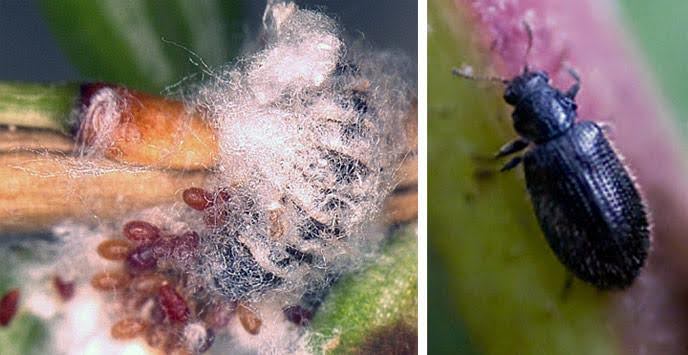On a warm day early in spring, a group of volunteers led by the National Park Service is surveying Sugar Hollow Reservoir, hoping to find a new resident living on hemlocks in the forest. They hold broad, white sheets under a tree and knock the needles with a long stick. What they’re looking for is so tiny that they need to use magnifying glasses to identify it.
Laricobius osakensis is a dark brown beetle between 2 and 3 millimeters long. It may be small, but its impact on the forest could prove to be quite large, particularly for the area’s towering hemlock trees. The beetle preys exclusively on hemlock woolly adelgid, an aphid-like insect that has been ravaging hemlock trees up and down the East Coast. The hemlock woolly adelgid has no natural predators in the area. So, in an effort to control the pest’s population, biologists with Shenandoah National Park released 500 Laricobius beetles at Sugar Hollow Reservoir in 2017.
“We call them Larry beetles for short,” says Rolf Gubler, a biologist with the park service. “As long as there’s hemlock infested with HWA, those little Larry beetles will disperse and find hemlock that’s infested. It has to be infested so they have a food source.”
Larry has been introduced to several sites in the park after being studied, and eventually reared, at Virginia Tech.
“We have over 13 different release sites throughout the park,” Gubler says. “We’ve released over 6,000 beetles since 2015, working closely with Virginia Tech and their entomology department.”
Scott Salom, director of entomology at Virginia Tech, first found and collected Larry beetles in British Columbia. Later, a Japanese source was found and started to be released in 2012. Salom says the Japanese version is preferred now to limit genetic variability in the area.
Larry’s prey, the hemlock woolly adelgid, also came to the area from Japan. It was initially found in an ornamental garden in Richmond in 1951. Shenandoah was the first park to encounter an infestation in 1988. A few years later, the park’s hemlock trees were rapidly declining and eventually dying.
“During that time, we lost a number of hemlocks,” Gubler says. “Hemlocks are typically found along streams, in riparian areas, or on northeast facing slopes, moister slopes, so they’re not that common. They were less than 1 percent of the cover type. But we saw this precipitous decline and mortality. By 2002, 2003, the park had lost anywhere between 90 to 95 percent of its hemlocks.”
Gubler says the decline looks like a gradual withering in the crown of the tree over the course of several years. If you stood under the branches looking up, over time you would see more and more light as the leaves turn yellow and fall.
The insect attaches to the base of the leaf where it meets the wood and penetrates the tree with a long, straw-like needle.
“The adelgid is sucking the sap, the sugars and the starches, out of the tree,” Gubler says. “It’s making it difficult for the tree to transport nutrients and water.”
Shade is actually a crucial ingredient that eastern hemlocks add to the forest ecosystem. Its tentlike cone of dense foliage creates a pool of shade around it.
“The hemlock creates this unique, cool microclimate that has a year-round canopy,” Gubler says. It creates cool, moist conditions that are important to the preservation of a number of different species.”
That includes the eastern brook trout, the black-throated green warbler, the red squirrel, and many others. Eastern hemlocks are considered a foundational species, meaning they occur in the mature stages of the forest, when the ecosystem is at its most complex and a wealth of species rely on ecological factors that have grown over time.
“They’re the mothership,” Salom says. “They’re the dominant species among a diverse collection of species. Another term would be a climax species. They’re the species that a lot of other plants and animals rely on, and they are critical in a lot of riparian habitat.”
Hemlocks can live for hundreds of years, which means they significantly shape the character of the forest around them, and their loss leaves a giant hole.
“We had 300- to 350-year-old hemlocks at Limberlost Trail,” Gubler says. “There were 100 old-growth trees in there, just beautiful trees that were 3-and-a-half, 4-foot wide at the base. We lost all of those due to HWA.”
The hemlock woolly adelgid is hard to control because its population can rebound quickly. In fact, extreme cold events in winter have killed up to 99 percent of the adelgid’s population in the past, but they built back up in a couple of years.
The adelgid population goes through two reproductive cycles each year. A spring generation hatches in April, matures in mid-June, and lays eggs. Those eggs hatch in early July, go dormant around August, and reactivate around the middle of October. That winter generation then lays eggs in March for the spring cycle to start again.
Larry beetles are active in the winter too and go dormant in the summer. “So, they’re really well adapted to their prey,” Salom says.
The beetles are effective in controlling the winter generation of adelgids, but since they’re dormant in the summer, that leaves a gap where the spring generation is able to rebound.
“Virginia Tech and others have always wanted to look for a complementary biocontrol to address that feeding gap,” Gubler says. Other potential predators are being studied to fill that gap, most notably the silver fly. But the park is looking to Larry as the primary biocontrol for the hemlock woolly adelgid.
Fortunately, there’s a good chance that Larry will make a home in Shenandoah as a protector of hemlocks. After examining the sheets, the group of surveyors counts 21 adults among their samples.
Gubler deems that a success. “We’re only sampling a small percentage of that hemlock tree’s foliage, so that’s pretty good,” he says. “If we’re recovering that many adults, that’s pretty decent.”
